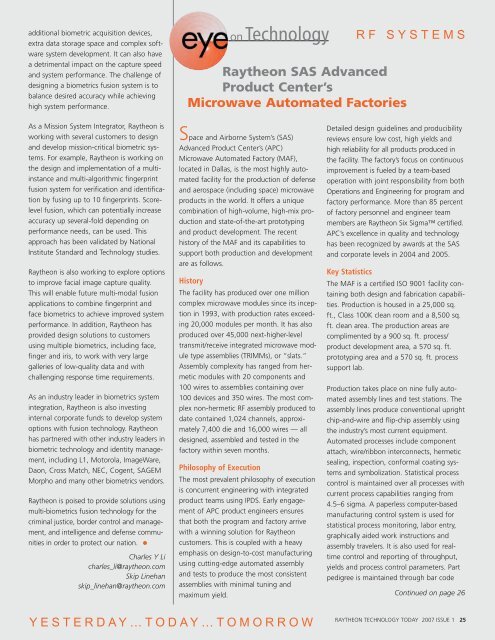Technology Today 2007 Issue 1 - Raytheon
Technology Today 2007 Issue 1 - Raytheon
Technology Today 2007 Issue 1 - Raytheon
Create successful ePaper yourself
Turn your PDF publications into a flip-book with our unique Google optimized e-Paper software.
additional biometric acquisition devices,<br />
extra data storage space and complex software<br />
system development. It can also have<br />
a detrimental impact on the capture speed<br />
and system performance. The challenge of<br />
designing a biometrics fusion system is to<br />
balance desired accuracy while achieving<br />
high system performance.<br />
As a Mission System Integrator, <strong>Raytheon</strong> is<br />
working with several customers to design<br />
and develop mission-critical biometric systems.<br />
For example, <strong>Raytheon</strong> is working on<br />
the design and implementation of a multiinstance<br />
and multi-algorithmic fingerprint<br />
fusion system for verification and identification<br />
by fusing up to 10 fingerprints. Scorelevel<br />
fusion, which can potentially increase<br />
accuracy up several-fold depending on<br />
performance needs, can be used. This<br />
approach has been validated by National<br />
Institute Standard and <strong>Technology</strong> studies.<br />
<strong>Raytheon</strong> is also working to explore options<br />
to improve facial image capture quality.<br />
This will enable future multi-modal fusion<br />
applications to combine fingerprint and<br />
face biometrics to achieve improved system<br />
performance. In addition, <strong>Raytheon</strong> has<br />
provided design solutions to customers<br />
using multiple biometrics, including face,<br />
finger and iris, to work with very large<br />
galleries of low-quality data and with<br />
challenging response time requirements.<br />
As an industry leader in biometrics system<br />
integration, <strong>Raytheon</strong> is also investing<br />
internal corporate funds to develop system<br />
options with fusion technology. <strong>Raytheon</strong><br />
has partnered with other industry leaders in<br />
biometric technology and identity management,<br />
including L1, Motorola, ImageWare,<br />
Daon, Cross Match, NEC, Cogent, SAGEM<br />
Morpho and many other biometrics vendors.<br />
<strong>Raytheon</strong> is poised to provide solutions using<br />
multi-biometrics fusion technology for the<br />
criminal justice, border control and management,<br />
and intelligence and defense communities<br />
in order to protect our nation. •<br />
Charles Y Li<br />
charles_li@raytheon.com<br />
Skip Linehan<br />
skip_linehan@raytheon.com<br />
on<strong>Technology</strong><br />
<strong>Raytheon</strong> SAS Advanced<br />
Product Center’s<br />
Microwave Automated Factories<br />
Space and Airborne System’s (SAS)<br />
Advanced Product Center’s (APC)<br />
Microwave Automated Factory (MAF),<br />
located in Dallas, is the most highly automated<br />
facility for the production of defense<br />
and aerospace (including space) microwave<br />
products in the world. It offers a unique<br />
combination of high-volume, high-mix production<br />
and state-of-the-art prototyping<br />
and product development. The recent<br />
history of the MAF and its capabilities to<br />
support both production and development<br />
are as follows.<br />
History<br />
The facility has produced over one million<br />
complex microwave modules since its inception<br />
in 1993, with production rates exceeding<br />
20,000 modules per month. It has also<br />
produced over 45,000 next-higher-level<br />
transmit/receive integrated microwave module<br />
type assemblies (TRIMMs), or “slats.”<br />
Assembly complexity has ranged from hermetic<br />
modules with 20 components and<br />
100 wires to assemblies containing over<br />
100 devices and 350 wires. The most complex<br />
non-hermetic RF assembly produced to<br />
date contained 1,024 channels, approximately<br />
7,400 die and 16,000 wires — all<br />
designed, assembled and tested in the<br />
factory within seven months.<br />
Philosophy of Execution<br />
The most prevalent philosophy of execution<br />
is concurrent engineering with integrated<br />
product teams using IPDS. Early engagement<br />
of APC product engineers ensures<br />
that both the program and factory arrive<br />
with a winning solution for <strong>Raytheon</strong><br />
customers. This is coupled with a heavy<br />
emphasis on design-to-cost manufacturing<br />
using cutting-edge automated assembly<br />
and tests to produce the most consistent<br />
assemblies with minimal tuning and<br />
maximum yield.<br />
Y E S T E R D A Y … T O D A Y … T O M O R R O W<br />
R F S Y S T E M S<br />
Detailed design guidelines and producibility<br />
reviews ensure low cost, high yields and<br />
high reliability for all products produced in<br />
the facility. The factory’s focus on continuous<br />
improvement is fueled by a team-based<br />
operation with joint responsibility from both<br />
Operations and Engineering for program and<br />
factory performance. More than 85 percent<br />
of factory personnel and engineer team<br />
members are <strong>Raytheon</strong> Six Sigma certified.<br />
APC’s excellence in quality and technology<br />
has been recognized by awards at the SAS<br />
and corporate levels in 2004 and 2005.<br />
Key Statistics<br />
The MAF is a certified ISO 9001 facility containing<br />
both design and fabrication capabilities.<br />
Production is housed in a 25,000 sq.<br />
ft., Class 100K clean room and a 8,500 sq.<br />
ft. clean area. The production areas are<br />
complimented by a 900 sq. ft. process/<br />
product development area, a 570 sq. ft.<br />
prototyping area and a 570 sq. ft. process<br />
support lab.<br />
Production takes place on nine fully automated<br />
assembly lines and test stations. The<br />
assembly lines produce conventional upright<br />
chip-and-wire and flip-chip assembly using<br />
the industry’s most current equipment.<br />
Automated processes include component<br />
attach, wire/ribbon interconnects, hermetic<br />
sealing, inspection, conformal coating systems<br />
and symbolization. Statistical process<br />
control is maintained over all processes with<br />
current process capabilities ranging from<br />
4.5–6 sigma. A paperless computer-based<br />
manufacturing control system is used for<br />
statistical process monitoring, labor entry,<br />
graphically aided work instructions and<br />
assembly travelers. It is also used for realtime<br />
control and reporting of throughput,<br />
yields and process control parameters. Part<br />
pedigree is maintained through bar code<br />
Continued on page 26<br />
RAYTHEON TECHNOLOGY TODAY <strong>2007</strong> ISSUE 1 25

















